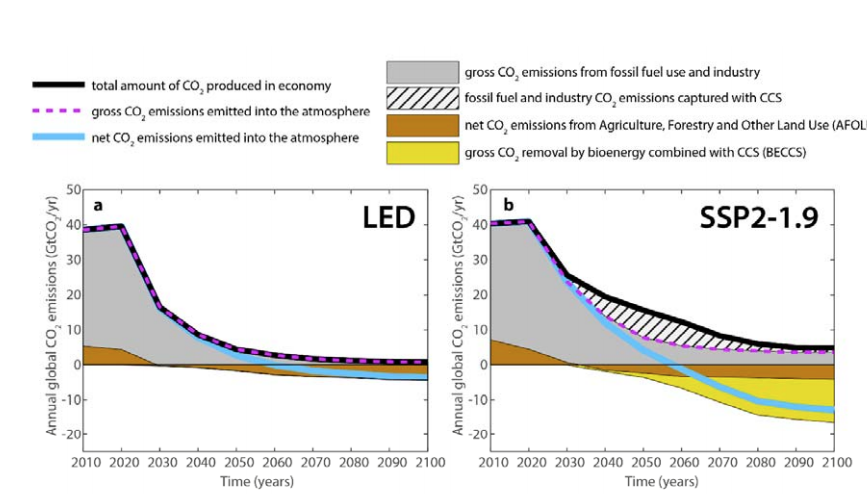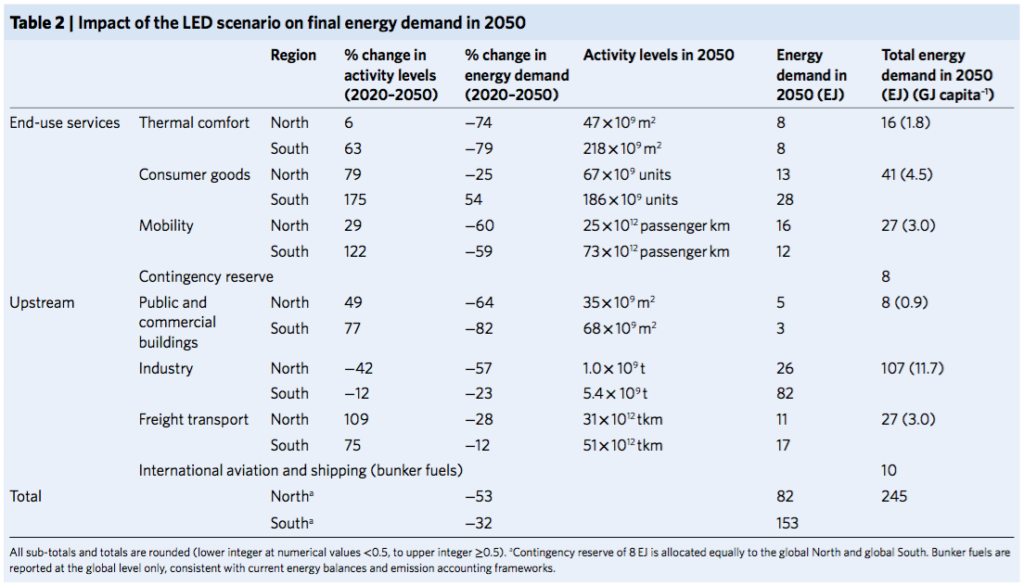
World can limit global warming to 1.5C by ‘improving energy efficiency’
Daisy Dunne
06.04.18Daisy Dunne
04.06.2018 | 4:00pmIt is possible to limit global warming to 1.5C and achieve many of the sustainable development goals without “negative emissions technologies”, a new study finds.
The research suggests that improving energy efficiency – chiefly by saving on everyday energy use – could play a major role in restricting warming to 1.5C above pre-industrial levels, which is the aspirational target of the Paris Agreement.
Emerging technologies, such as multipurpose smartphones and electric autonomous cars, could be key to improving energy efficiency both in the developed world and the global south, the lead author tells Carbon Brief.
The “landmark” study provides policymakers with tools to implement strategies to rapidly increase energy efficiency, another scientist tells Carbon Brief.
Negative emissions
Under the Paris Agreement, countries agreed that warming should be limited to “well below” 2C above pre-industrial levels, with efforts to keep it below 1.5C. Since then, researchers have developed a range of scenarios to explore how this could be achieved.
Until recently, scenarios limiting warming to 1.5C have typically relied on the rapid and widespread deployment of negative emissions technologies (NETs).
NETs are a group of methods – many still in development – that would limit global warming by removing CO2 from the air and storing it on land, underground or in the oceans.
In particular, most 1.5C scenarios assume that the world will develop large-scale bioenergy with carbon capture and storage (BECCS). Put simply, BECCS involves burning biomass – such as trees and crops – to generate energy and then capturing the resulting CO2 emissions.
The assumption that BECCS will be needed to reach 1.5C has proved controversial among some groups. This is because BECCS has yet to be demonstrated at a commercial scale and research suggests that deployment would take up large amounts of land, which could threaten food production and wildlife.
In March, Carbon Brief covered research showing, for the first time, how the world could limit warming to 1.5C with “minimal to no” BECCS. The study looked at several pathways for tackling climate change without BECCS, including by adopting low-meat diets, limiting population growth and by increasing crop yields.
However, the new study, published in Nature Energy, describes an alternative scenario where warming is limited to 1.5C by improving energy efficiency, with no use of negative emissions technologies.
Increasing efficiency would also come with significant co-benefits for the developing world, says study lead author Dr Charlie Wilson, a scientist from the Tyndall Centre for Climate Change Research. He tells Carbon Brief:
“We develop a coherent big-picture storyline of how the world may change from today to 2050, identifying key drivers of change including: rising quality of life, urbanisation, digitalisation, and decentralisation of the energy system.
“We find that global warming can be limited to 1.5C without relying on negative emission technologies by reducing the energy required to provide for rising living standards – particularly in the global South.”
Alternative future
In their paper, the researchers present an alternative future – called the Low Energy Demand (LED) scenario – where warming is limited to 1.5C while many of the world’s sustainable development goals (SDGs) are fulfilled, including the goals of “zero hunger”, “good health and wellbeing” and “affordable and clean energy” for all.
![]()
Using integrated assessment models (IAMs), the researchers explore how improving energy efficiency across two groups – the global north and the global south – could help the world limit warming to 1.5C.
The charts below show how the LED scenario (left) compares to one of the Shared Socioeconomic Pathways (SSPs) – a range of scenarios that examine how global society, demographics and economics might change over the next century.
The pathway SSP2-1.9 (right) is a “middle-of-the-road” scenario which assumes the world follows a path in which social, economic, and technological trends do not shift markedly from historical patterns. The pathway assumes that warming is limited to 1.5C (RCP1.9) – largely through the use of BECCS.
On each chart, total emissions from fossil fuel use (grey) and agriculture, forestry and other land use (AFOLU; brown) are shown. For SSP2-1.9, total negative emissions as a result of CO2 capture of fossil fuel emissions (hatched black) and BECCS (yellow) are also shown.

Total emissions from fossil fuel use (grey), agriculture, forestry and other land use (brown), use of carbon capture and storage in the fossil fuel industry (hatched black) and BECCS (yellow) for the Low Energy Demand (LED) scenario and SSP2-1.9. Source: Grubler et al. (2018)
The charts show that, in the LED scenario, the total amount of CO2 produced is expected to fall rapidly between 2030 and 2100. This is largely driven through improvements to energy efficiency, the researchers say.
Leading innovation
In the scenario, improvements in energy efficiency are largely driven by technological and social innovations, such as the spread of digital services in the global south and the rise of vehicle-sharing in the global north, says Wilson:
“We don’t focus on behavioural change as a result of conscious or ‘mindful’ awareness of energy consumption – rather we focus on consumer-facing innovations which may prove attractive because they’re cheaper, cleaner, quicker, more sociable, easier, more convenient or otherwise ‘better’.”
The study does not directly address the Jevons paradox – which occurs when technological innovation increases efficiency – but also demand for the resource – leading to a rise in overall consumption. However, indirectly, the results are robust to the Jevons effect, Wilson says:
“We sensitised our results by increasing energy demand by up to 50% (relative to the main LED scenario) and we found we could still limit warming to 1.5C without BECCS. So the basic insight of the scenario is robust to rebound of up to 50%, which is above the typical range of direct rebound effects found in the literature.”
These changes are made at both the consumer (end-use services) and industrial (upstream) level. The table below summarises the expected changes to energy demand from different sectors in the global north and south.

Summary of changes to activity levels and energy demand expected in the global north and south for various end-use services and upstream sectors in the LED scenario. Source: Grubler et al. (2018)
The table shows how, in most sectors, energy demand is expected to decrease despite rises in activity levels. This reflects steep increases in energy efficiency across each sector, Wilson says.
For example, the scenario expects the ownership of “consumer goods” – household appliances used for cooking, entertainment and communication – to increase by 80% in the north and by a factor of three in the south.
However, the scenario expects that “energy efficiency improves significantly per device”, the paper notes:
“The integration of multiple service functions in single devices (particularly smartphones) yields up to a 100-fold potential power savings while in use. Devices increasingly become ‘smart’ and interconnected, which opens up potential for controllability.”
The scenario also considers that mobility-related activity (such as owning a car and using public transport) is expected to double in the global south as populations, incomes and leisure opportunities rise.
However, the scenario expects that “the rapid market diffusion of electric cars” will allow for large power savings despite surges in demand.
In the north, the scenario expects that further savings will be made as ride-sharing rises in popularity. The paper notes:
“Real-time information via mobile devices support shared vehicle fleets (including autonomous vehicles) and flexible transit systems. By 2050, the total vehicle numbers halve to around 850m light-duty vehicles.”
Changing land use
While the scenario focuses on changes in energy use, it also includes some other assumptions.
For example, the scenario expects the global food supply to expand by one-third globally to feed growing populations and to eradicate hunger in the developing world.
In the scenario, this is achieved by agricultural intensification and by a switch to “healthier diets”, which include less red meat and more fruit and vegetables. The table below shows expected changes to calorie and meat consumption from 2020-2100.

Expected changes to calorie and meat consumption in the global north and south from 2020-2100 in the LED scenario. Source: Grubler et al. (2018)
The scenario expects that, in the north, calorie consumption will remain relatively constant over time. This is because further rises in income and choice may lead to more calorie consumption, but the rise may be roughly offset by advances in health awareness and quality of life, Wilson says.
In comparison to today, red meat consumption is expected to fall “very slightly” in both the north and south by 2050, Wilson says. In the research paper’s supplementary information, the authors note:
“In all regions, consumer awareness mixed with climate policy incentives also influence the composition of diets at the product level, with less rice and red meat consumption.”
The scenario also expects forest cover to increase by 300m hectares by 2100. These additional trees are expected to absorb 168bn tonnes of CO2.
This is largely achieved by creating new forests (afforestation), Wilson says. The research team do not consider afforestation to be a negative emissions technology, he adds:
“Afforestation may be a net sink and so ‘negative emissions’, but we do not consider it to be a ‘technology’.”
‘Landmark’ study
The findings show that policymakers should focus on implementing strategies to improve energy efficiency, Wilson says:
“Focusing on energy services and the energy required to provide those services is the single most important way of addressing climate change while raising living standards.”
The study shows how improving energy efficiency could have co-benefits for the environment and society, says Prof Detlef van Vuuren, senior researcher in the department of climate, air and energy at the PBL Netherlands Environmental Assessment Agency, who was not involved in the study. In March, van Vuuren published a study looking at 1.5C scenarios without BECCS. He tells Carbon Brief:
“It is unlikely we can get to 2C or 1.5C without negatieve emissions, but given the risks involved in a large scale use of negative emissions, it is really important to explore pathways that could tell us how to minimise their use. As such, it is a landmark study that could help policymakers to focus more on implementing strategies to rapidly increase energy efficiency.”
The research highlights how a societal shift will be necessary to limit global warming to 1.5C without NETs, says Dr Mark Workman from Imperial College London’s Energy Futures Lab, who was not involved in the research. He tells Carbon Brief:
“Hitting 2C – let alone the 1.5C climate target – is probably unobtainable without radical and disruptive change in all elements of society, the impacts of which will be unequally distributed.”
Grubler, A. et al. (2018) A low energy demand scenario for meeting the 1.5C target and sustainable development goals without negative emission technologies, Nature Energy, https://www.nature.com/articles/s41560-018-0172-6
-
World can limit global warming to 1.5C by ‘improving energy efficiency’
-
Energy efficiency could help limit global warming to 1.5C, study says

